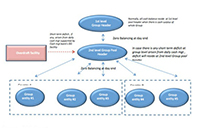Financial Planning and Analysis: A cost-savings frontier too far
Stanley Tan, Head of Working Capital Advisory, Global Transaction Services at DBS

Financial planning and analysis (FP&A) is the next frontier in the outsourcing wave, but one that should be cautiously approached – and crossed only in select circumstances. Despite the continuing pressure to find cost savings and efficiency gains within the finance function, firms have more to lose than gain.
FP&A is a term open to a variety of interpretations, but for the purposes of this article FP&A activities can be defined as those which include using financial data, rather than the production or extraction of data; so employing said data for planning, analytics or other purposes such as corporate strategy or corporate finance.
The astute reader might ask: what about reports and reporting? This will depend on what the reports are for and how they are used. So, the production of reports – for instance, of sales volume by country – should not be FP&A per se, whereas using them to evaluate the impact of a new sales-transformation implementation plan would be considered FP&A.
Notably, there appears to be no clear, consistent definition of FP&A – a point that this light-hearted blog post makes abundantly clear. If you are considering FP&A outsourcing, this definitional grey-zone is one that is critical to sort out. Go beyond asking what activities are performed and link these to the purpose of such activities; doing so will help clarify the extent of potential savings in the outsourcing exercise.
In fact, if you are looking to outsource FP&A and actively seeking cost savings, be thorough on reviewing the need for reports. Far too often, reports get “grandfathered-in” and are produced only when they are no longer relevant, or at times, no longer used. One of the best tests – particularly for large corporations – is to follow the trail: map out who uses each report that gets produced and determine whether it’s really needed or just “nice-to-have”. End-users usually maintain that everything is ‘needed,’ so probe further. When the value of a report is dubious, you could simply stop producing it. If you’re more cautious, produce it but simply wait rather than immediately press ahead with distribution: where there’s a genuine need for the report, end-users will quickly ask for it. If not, you can safely stop producing it going forward and reassign resources accordingly. Personal experience suggests that some 40% to 50% of discontinued reports are never missed or asked for again.
Ask yourself how actively your company phases out reports. There is a continual for new reports and data, but how often do older ones get decommissioned? If the answer is ‘rarely’ or ‘never’, that’s a red flag and you could unearth savings without having to look at FP&A outsourcing.
The case for in-house FP&A:
Three main reasons explain why firms tend to lose more than they gain if they outsource FP&A:
- FP&A is the foundational building block for effective strategic planning:
The key value-add of FP&A is the ability to make sense of the numbers, distil implications and insights, then use the findings to formulate strategies to drive the business forward. Often, the chief financial officer (CFO) is the individual within senior management to have mastery of the numbers and trends, both historical and forward-looking. In recent years that role has expanded beyond merely supporting strategy, to actively leading and shaping strategy.
For help in these tasks, the CFO often leans on the FP&A team. FP&A is the critical interconnection that can get into the details of numbers and data systems and dig hard to validate the veracity of numbers, while also piecing all this together to formulate strategy. FP&A professionals help act as a second level of checks and balances, to ensure that data is read accurately and that policy is not formed based on any erroneous interpretations.
By outsourcing FP&A, one runs the risk of fracturing this interconnection. The CFO and senior management not only lose a team of FP&A professionals who can see both the big picture and details; but also gone is the ability to interpret numbers in a company-specific context. Consider the acronyms, nuances and organisational specifics that your particular company may have, and think about it in the context of cost benefit if you outsource FP&A. - FP&A is linked to bench strength and talent management:
Building on the above, an added benefit of keeping FP&A in-house is the role it can play to develop talent. This includes building bench strength within the finance function, as well as management talent across the business.
The ability to maintain both a high-level strategic view, as mentioned, with the sharpness to problem-solve data cleanliness and/or process issues is highly prized; as such the FP&A role – if set up well – is a platform to develop and train talent.
While difficult to quantify, it is worth assessing how useful this role might be and the hidden benefit linked to keeping the FP&A function in-house. - FP&A helps shape the data architecture of the future:
A further but often-overlooked aspect of FP&A is the role it plays in shaping future data needs. As users of data, they can actively input and shape its visibility, transparency and integrity of the data. Put another way, with the backing of senior management FP&A is positioned to request and ensure that the relevant data is presented and seen. Most importantly, if the data is not in the appropriate format, it can effect relevant change.
If FP&A is outsourced, it is unclear who can play this role. As skilful as the outsourced vendor might be, it is unlikely they can fully understand or appreciate what’s needed from the business side; over time this disconnect results in a less flexible information system. This is a hidden cost of outsourcing that should not be neglected.
Moreover, there is an increasing need for businesses to be more agile and flexible. This need extends to strategy, supply chain, sales, operations and even risk management. As such, FP&A helps lubricate the wheels of change as it can articulate the value – and constraints – of existing data systems. This flexibility, while not entirely lost, is compromised if FP&A as a function is outsourced.
Conclusion
Ultimately, when FP&A outsourcing is considered, there must be clarity on what and why this is being done as well as willingness to accept the trade-offs. Certain activities related to production and extraction of data could be candidates for outsourcing. However, one should avoid throwing out the baby with the bathwater; which means expertise related to using data remaining in-house.
(This article was first published in GTNews: Financial Planning and Analysis: a cost-savings frontier too far.)
Subscribe to DBS BusinessClass
Stay updated with the latest market trends and industry insights, connect with a network of entrepreneurs, and gain access to exclusive event invitations. Join Asia's fastest growing business community – get your complimentary membership here.




